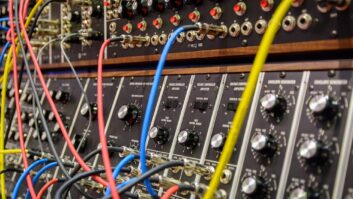There was a time when, even in recent memory, someone who was shopping for a good pair of bi-amplified studio monitors needed more than $1,000 to get started. Then, Genelec broke the $1k barrier with the excellent 1029 monitor. (List price for the current 1029AP is $1,080/pair.) Two years ago, Event upped the ante with the Project Studio (PS) Series; at just under $500 a pair, the PS6 was a steal. (Current list is $699/pair.) Many other companies have since introduced compact studio monitors at very competitive prices.
M-Audio, a company known mainly for digital audio cards and MIDI products, has recently entered the market with its SP Series monitors, available with a 5-inch or an 8-inch woofer. M-Audio has also added a subwoofer, the SP-8S ($499.95), for those who are looking for more bass response. For this test, I took the SP-5B model ($399.95/pair) without the subwoofer.
The SP-5B is constructed of 15mm vinyl-laminated MDF encased in a 0.4mm PVC shell. The monitors measure 9.85×6.54×7.88 (H×W×D) and weigh 28 pounds a pair. Each cabinet contains a 5¼-inch magnetically shielded, mineral-filled polypropylene curved cone with a high-temperature voice coil and a damped rubber surround, and a 1-inch magnetically shielded, swivel-mounted, silk-dome tweeter with a Ferro-Fluid coolant and internal damping. The monitors boast a fourth-order active crossover (2.7 kHz), and separate amplifiers supply 42 watts to the woofer and 33 watts to the tweeter, a total of 75 watts of power. An LED on the front of each monitor indicates power on, and there are XLR and TRS inputs on the back, which is also where the volume control is located, an unfortunate choice. Frequency response is 33 to 22 kHz, while the signal-to-noise ratio is greater than 100 dB (full output, 20 kHz bandwidth). The monitors also feature a sub-frequency port on the back that is designed to discharge extreme low frequencies under 30 Hz.
THE SOUND
For my initial listening tests, I set the monitors up about four feet apart with the drivers at ear level and connected my SEK’D soundcard to the ¼-inch inputs on the monitors. My first choice for listening was Rush’s live CD Exit…Stage Left, because I think “YYZ,” which begins with the light Neal Peart rhythm and then jumps immediately into Geddy Lee’s driving bass, is a good test. Initial impressions were good. The cymbals seemed well-defined, and the bass response was strong. I tried a variety of other test CDs, including Led Zeppelin’s BBC Sessions, the Rolling Stones’ Exile on Main Street, Natalie Merchant’s Motherland and the Cowboy Junkies’ live Waltz Across America. For acoustic music, I chose fiddler Kevin Burke’s In Concert, Karan Casey’s The Winds Begin to Sing, and Tim O’Brien and Darrell Scott’s Real Time. I was impressed with the balance that the speakers showed. The bass response, in particular, was impressive on all of the material, while the highs sounded tight. On all of the rock-oriented material, the monitors did a good job, especially at reproducing the cymbals, which is something I always listen for. On the O’Brien and Scott material, the mandolin sounded smooth and clear, while the “high lonesome” vocals were crystal-clear.
TEST, 1, 2
The acid test came when I took the monitors over to my friend Marc Nutter’s Sonic Sense studio to A/B the SP-5Bs against a pair of Genelec 1029s; perhaps not the fairest test, but a good barometer of the monitor’s overall strengths and weaknesses. For kicks and giggles, we also set up an Earthworks microphone about a foot away from the right monitor and ran Smaart Live to test both sets. Though the Genelec 1029s cost more than twice the M-Audio SP-5Bs, the SP-5Bs did quite well. In particular, the SP-5Bs actually had more present bass than the 1029s, evidence that the sub-frequency port was working. The Smaart Live analysis backed this up, showing that the M-Audio SP-5Bs exhibited a smaller initial drop-off, followed by a quick spike before a sharper drop-off in the bass frequencies. After the second drop-off, both monitors came up at a similar rate. The other interesting thing in the M-Audio response that Smaart Live revealed was a spike at 1 kHz and a small drop-off at 4 kHz, after which the response quickly rebounded.
Overall, the Genelec 1029s sounded more refined and had a crisper high-end definition than the M-Audio SP-5Bs. When I listened to a CD by Irish supergroup the Bothy Band, the pipes, fiddle and flute came through a little smoother in the Genelec 1029s, but the M-Audio monitors were by no means lacking. Even after several hours of listening, I did not experience any ear fatigue.
At its current price of $399.95/pair, the M-Audio SP-5B is definitely worth consideration for a project studio. With its magnetic shielding and small size, the bi-amplified monitor is particularly well-suited for use with a PC-based DAW in a small studio.
M-Audio, 45 East Saint Joseph St., Arcadia, CA 91006; phone 800/969-6434; www.midiman.net.

